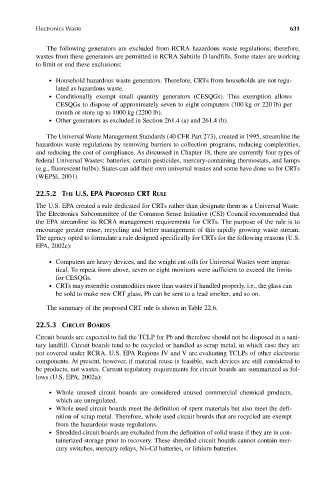Page 660 - Materials Chemistry, Second Edition
P. 660
CAT3525_C22.qxd 1/27/2005 1:00 PM Page 631
Electronics Waste 631
The following generators are excluded from RCRA hazardous waste regulations; therefore,
wastes from these generators are permitted in RCRA Subtitle D landfills. Some states are working
to limit or end these exclusions:
● Household hazardous waste generators. Therefore, CRTs from households are not regu-
lated as hazardous waste.
● Conditionally exempt small quantity generators (CESQGs). This exemption allows
CESQGs to dispose of approximately seven to eight computers (100 kg or 220 lb) per
month or store up to 1000 kg (2200 lb).
● Other generators as excluded in Section 261.4 (a) and 261.4 (b).
The Universal Waste Management Standards (40 CFR Part 273), created in 1995, streamline the
hazardous waste regulations by removing barriers to collection programs, reducing complexities,
and reducing the cost of compliance. As discussed in Chapter 18, there are currently four types of
federal Universal Wastes: batteries, certain pesticides, mercury-containing thermostats, and lamps
(e.g., fluorescent bulbs). States can add their own universal wastes and some have done so for CRTs
(WEPSI, 2001).
22.5.2 THE U.S. EPA PROPOSED CRT RULE
The U.S. EPA created a rule dedicated for CRTs rather than designate them as a Universal Waste.
The Electronics Subcommittee of the Common Sense Initiative (CSI) Council recommended that
the EPA streamline its RCRA management requirements for CRTs. The purpose of the rule is to
encourage greater reuse, recycling and better management of this rapidly growing waste stream.
The agency opted to formulate a rule designed specifically for CRTs for the following reasons (U.S.
EPA, 2002c):
● Computers are heavy devices, and the weight cut-offs for Universal Wastes were imprac-
tical. To repeat from above, seven or eight monitors were sufficient to exceed the limits
for CESQGs.
● CRTs may resemble commodities more than wastes if handled properly, i.e., the glass can
be sold to make new CRT glass, Pb can be sent to a lead smelter, and so on.
The summary of the proposed CRT rule is shown in Table 22.6.
22.5.3 CIRCUIT BOARDS
Circuit boards are expected to fail the TCLP for Pb and therefore should not be disposed in a sani-
tary landfill. Circuit boards tend to be recycled or handled as scrap metal, in which case they are
not covered under RCRA. U.S. EPA Regions IV and V are evaluating TCLPs of other electronic
components. At present, however, if material reuse is feasible, such devices are still considered to
be products, not wastes. Current regulatory requirements for circuit boards are summarized as fol-
lows (U.S. EPA, 2002a):
● Whole unused circuit boards are considered unused commercial chemical products,
which are unregulated.
● Whole used circuit boards meet the definition of spent materials but also meet the defi-
nition of scrap metal. Therefore, whole used circuit boards that are recycled are exempt
from the hazardous waste regulations.
● Shredded circuit boards are excluded from the definition of solid waste if they are in con-
tainerized storage prior to recovery. These shredded circuit boards cannot contain mer-
cury switches, mercury relays, Ni–Cd batteries, or lithium batteries.

